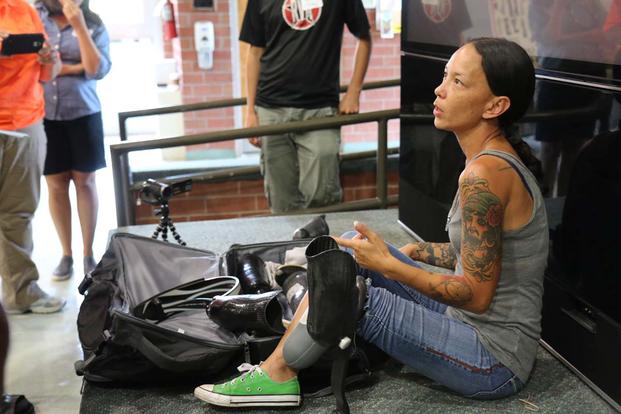Eric Young was only eight months out of the Marine Corps in 2008 when he lost his right arm during a tree-cutting accident. And one of the things he misses most - and what he wants back - is the ability to ride his motorcycle.
Lisamarie Wiley lost her left leg below the knee when she stepped on a mine in Afghanistan, where she was serving with the 10th Mountain Division. What she wants is a prosthetic that does not have to be customized for her specific height, or for what shoe she wants to wear.
On Tuesday, Young, Wiley and two other veterans detailed their requests at the VA Medical Center in Richmond, Virginia, where they discussed their challenges to a diverse gathering of would-be problem solvers who immediately went to work trying to find solutions as part of a VA-sponsored "Make-a-thon."
The two-day program, which continues through Wednesday, has brought a nationwide mix of professionals, college students and even high school students interested in coming up with a new idea in the science and technology of prosthetics.
"I think it's going great. I like the idea of this open forum where they can put these ideas forth," said John Fox, chief of the orthotics and prosthetics lab at the facility and one of the VA staff members serving as roving mentors to the attendees.
In some ways the event resembles the TV series "Shark Tank," in which budding entrepreneurs attempt to pitch their ideas of potential investors.
On Tuesday, individuals or members of teams took to the floor to pitch their ideas to the VA staff, veterans and each other. Some who came unattached to a team formed one with other individuals or joined existing teams, based on what their ideas and what they thought they could bring to the challenge.
Event collaborators included several additive manufacturing companies who brought in more than a dozen machines to the forum to try to turn any new ideas into an actual product.
Brad Poziembo and Garry Biddle of Daytona Artificial Limb in Ohio teamed with Anita Shaamee and Kaila Grenier, biomedical engineering students at the University of Virginia in Charlottesville, to work on problems of limb movement within prosthetic sockets.
An improperly fitted socket, or one that gets loose, can cause irritation and blistering on the limb.
"We're working on trying various textures within the socket," Grenier said. Right now the interior of the socket turned out by Poziembo's machine, which he set up at the event, is a continuing spiral. Their team is going to try some other patterns, starting with semi-circles, to learn if these changes help hold the socket in place better.
On Wednesday, the 3D design solutions will be placed in competition and judged by a six-member panel that includes representatives from the VA, Toyota, 3D Systems and Google.
Google will award the overall winning design team $20,000. There will also be awards of $2,000 and $1,000 in separate categories.
Wiley, who was a human intelligence collector in the Army, quickly found herself surrounded at the foot of a low stage, showing the half-dozen or so prosthetic legs she brought with her. There was the curved blade leg for running, another leg with a sneaker on it, and another with a high-heeled shoe for a night out.
All in all, Wiley has 12 legs. Not because she wants 12, but because each leg still must be made on a custom basis - and so you need a different leg for different kinds of activities. There is not yet a leg that can be bought off the shelf and adjusted to fit.
Worse still, she says, travel means packing a half dozen legs in a bag that will not fit in carry-on and so have to be checked in.
"This leg cost about $70,000," she said, holding up one. She points to two others. "These together cost about $50,000. I mean, you really want to give your Porsche to some baggage handlers to throw around?"
3D Printing
The two-day Make-a-thon is aimed at accelerating the development of prosthetics, with an emphasis on 3D printing, which is considered critical in the development of prosthetics manufacturing.
Young was enthusiastic about what the ideas he heard from Edward Levis, a technology educator with the Post Oak Middle School in Middle School in Spotsylvania, Virginia, and Kayleigh Childress, one of his students. On note paper, while talking with Young, they sketched out a prosthetic arm that they believe would allow Young to ride motorcycles once more.
Since Young has complete movement with the remainder of his shoulder, he could use it to manipulate the artificial hand on the handle. He would not need to have to bend the elbow, just be able to turn the arm to turn the bike, Levis said.
They also came up with a basic wrist design allowing for a quick release if Young spilled the bike or otherwise needed to get off it quickly.
It all sounded good to Young, who said he's not even concerned with getting the okay from the Department of Motor Vehicles.
"That won't be a problem," he said. "The motorcycle stamp is still valid on my license."
-- Bryant Jordan can be reached at bryant.jordan@military.com





























